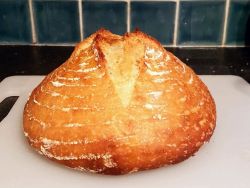Earlier in the week, I made very disappointing sourdough bread. It was supposed to be a round sourdough “boule” but it ended up cone-shaped. It tasted “ok” -but only “ok” and definitely wasn’t nice looking. I knew what I’d done wrong, sometimes I push the boundaries too far and I lose. To help you troubleshoot your sourdough bread issues I’ve explained what went wrong in my cone-shaped bread and other sourdough bread disasters I’ve dealt with before. For help with your starter, I have a page dedicated to sourdough starter troubleshooting.
Implementing a few of these simple changes enables me to make professional-quality sourdough bread at home – ones that aren’t usually cone-shaped!
Why was my sourdough bread cone-shaped?
Basically, your starter is weak. Even though it had been fed for a couple of days it was not strong enough to raise the bread. Wild yeasts and lactic acid bacteria did produce some gas, the issue lies in the lack of dough conditioning. The smell of the sourdough wasn’t well perfumed which is a sign of it not being ripe.

A young starter will have some unusual smells. It needs time for the lactic acid bacteria to overpower the unwanted bacteria and create a stable ecosystem. In the case of this bread, the lower levels of lactic acids led to poor gas retaining properties in the gluten. The dough wasn’t able to capture the gas effectively during proofing and oven spring.
Why have I got a frisbee bread?
If your bread is completely flat it’s likely that the dough has been over fermented or there is too much water in the recipe. Start again using a reliable recipe such as my sourdough bread recipe for beginners, check your starter is nice and active and that the temperatures and timings are correct.
Why have I got tunnelling in my sourdough bread?
Tunnelling, or long air pockets that go through the length of the bread are a common sourdough bread troubleshooting issue. They appear because the gluten structure is weak and the dough has become excessively acidic. This is due to a lack of dough maturity and a long fermentation or proofing time. The reason why this is so common is that the starter wasn’t ripe enough and the baker pushes the rise until the desired height is achieved. If you discover tunnelling, feed your starter at least once a day for a week to increase activity before trying again.
How to get my sourdough bread to stay fresh for longer
To keep sourdough bread fresh, adding fat or oil to the dough will help to lubricate it and extend its life. One of the biggest causes of staling in sourdough home-baked bread is that it spends too long in the oven and moisture is lost. Reducing the baking time by increasing the heat can transform the quality and freshness of your bread. If you are baking sourdough using the cold oven method, switching to a preheated baking stone often makes a massive improvement to shelf life.
Keeping the kitchen clean and using clean hands and equipment prevents new bacteria from being introduced and creating mould or spoiling the flavour of the bread.
Another trick is to seal the bread before it cools down completely. Once the bread cools to 35C (95F), get it wrapped and it will lock in moisture without going mouldy.
Sourdough troubleshooting frequently asked questions
If you’ve enjoyed this article and wish to treat me to a coffee, you can by following the link below – Thanks x

Hi, I’m Gareth Busby, a baking coach, head baker and bread-baking fanatic! My aim is to use science, techniques and 15 years of baking experience to help you become a better baker.
Table of Contents
Related Recipes
Related Articles
Keep up to date with the latest Articles, Recipes & Bread Baking info by joining my mailing list
Join The Weekly Bread Baker's Newsletter!
Latest Articles
Baking Categories
Disclaimer
Address
8 Woodland Avenue,
Worthing
West Sussex
BN13 3AF
UK









